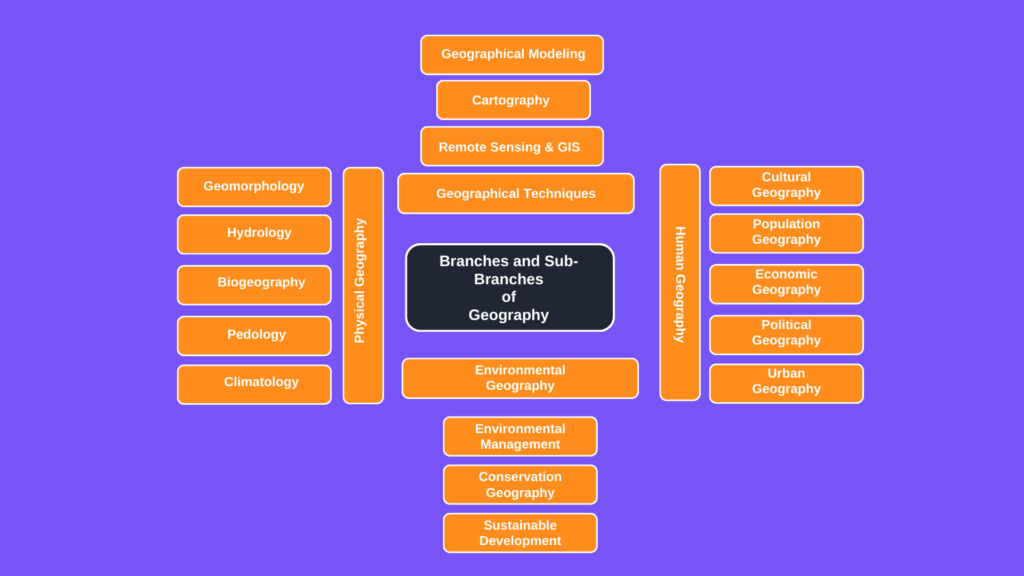Branches and Sub Branches of Geography
Geographical Thought
Index
Introduction
Geography is a multifaceted discipline that explores the earth's surface and its phenomena. It encompasses a broad array of topics, ranging from physical features and natural processes to human societies and their interactions with the environment.
The study of geography can be divided into several branches, each focusing on distinct aspects of the earth and its inhabitants. These branches often intersect and overlap, reflecting the complex relationship between humans and their surroundings.
Branches and Sub-Branches of Geography

Advertisement
1- Physical Geography:
Physical geography is concerned with the natural features and processes of the earth. It examines the landforms, climates, soils, vegetation, and hydrology that shape the planet's surface.
Sub-branches of physical geography include:
Geomorphology: This branch studies the formation and evolution of landforms, including mountains, valleys, rivers, and coastlines. It investigates the processes such as erosion, weathering, and tectonic activity that shape the earth's surface.
Climatology: Climatology focuses on the long-term patterns and variations of climate across different regions. It explores factors like temperature, precipitation, atmospheric pressure, and winds, as well as phenomena such as climate change and global warming.
Biogeography: Biogeography examines the distribution of plants and animals across the earth's surface and the factors that influence their spatial patterns. It considers ecological processes, historical events, and human impacts on biodiversity.
Hydrology: Hydrology studies the distribution, movement, and quality of water on the earth's surface, including rivers, lakes, oceans, and groundwater. It investigates processes such as precipitation, evaporation, runoff, and water cycle dynamics.
Pedology: Pedology focuses on the formation, composition, and distribution of soils. It explores soil properties, classification systems, and their significance for agriculture, ecology, and land use planning.
2- Human Geography:
Human geography examines the relationship between human societies and their environments. It investigates patterns of population distribution, cultural practices, economic activities, and urban development.
Sub-branches of human geography include:
Cultural Geography: Cultural geography studies the spatial distribution of cultural traits, such as language, religion, customs, and traditions. It explores how cultural landscapes are shaped by human activities and interactions.
Population Geography: Population geography analyzes the distribution, density, composition, and migration patterns of human populations. It examines factors influencing population growth, such as fertility rates, mortality rates, and migration trends.
Economic Geography: Economic geography explores the spatial patterns of economic activities, such as agriculture, industry, trade, and services. It investigates factors like resource availability, infrastructure, market dynamics, and globalization.
Political Geography: Political geography examines the spatial organization and territorial dynamics of political entities, such as states, nations, and borders. It considers geopolitical relationships, sovereignty issues, and the impact of political ideologies on landscapes.
Urban Geography: Urban geography focuses on the spatial structure, dynamics, and challenges of cities and metropolitan areas. It explores issues such as urbanization, land use planning, housing, transportation, and social inequality.
3- Environmental Geography:
Environmental geography integrates aspects of physical and human geography to study the interactions between humans and their environment. It examines environmental issues, conservation strategies, and sustainable development.
Sub-branches of environmental geography include:
Environmental Management: Environmental management focuses on the planning, regulation, and stewardship of natural resources and ecosystems. It addresses issues such as pollution control, resource depletion, habitat conservation, and environmental policy.
Conservation Geography: Conservation geography explores the spatial patterns of biodiversity, habitat loss, and ecosystem degradation. It investigates strategies for biodiversity conservation, protected area management, and landscape restoration.
Sustainable Development: Sustainable development aims to meet the needs of the present without compromising the ability of future generations to meet their own needs. It integrates environmental, social, and economic considerations to promote equitable and environmentally responsible development.
4- Geographical Techniques:
Geographical techniques encompass the methods and tools used to collect, analyze, and visualize geographic data. They include:
Geographic Information Systems (GIS): GIS integrates geographic data layers to analyze spatial relationships and patterns. I t is used for mapping, spatial analysis, and decision-making in various fields.
Remote Sensing: Remote sensing involves the use of satellite and aerial imagery to monitor and study the earth's surface. It provides valuable data for environmental monitoring, land use mapping, and natural resource management.
Cartography: Cartography is the art and science of mapmaking. It involves the design, production, and interpretation of maps to represent spatial information effectively.
Geographic Modeling: Geographic modeling uses mathematical and computational techniques to simulate and predict spatial phenomena. It is used for scenario analysis, risk assessment, and planning purposes.
Advertisement
Conclusion :
In summary, geography encompasses a diverse array of branches and sub-branches that collectively explore the earth's surface and its inhabitants. From physical features and natural processes to human societies and environmental issues, geography provides valuable insights into the complexity of our planet and the interactions that shape it.
By understanding these relationships, geographers contribute to informed decision-making and sustainable management of the earth's resources for future generations.
Share
Advertisement
Other Topics
Unit - I
Advertisement
Back to
Advertisement
Advertisement

